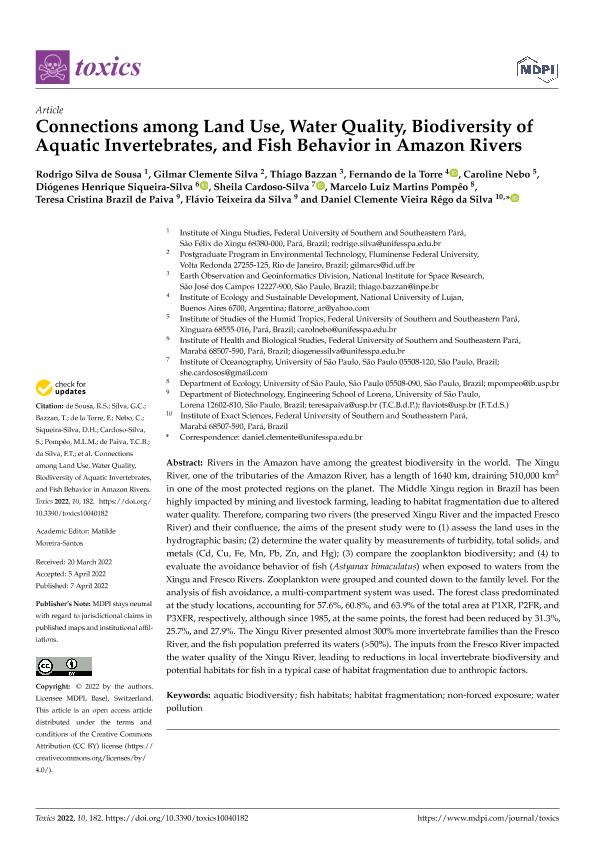Mostrar el registro sencillo del ítem
dc.contributor.author
Silva de Sousa, Rodrigo
dc.contributor.author
Silva, Gilmar Clemente
dc.contributor.author
Bazzan, Thiago
dc.contributor.author
de la Torre, Fernando Roman

dc.contributor.author
Nebo, Caroline
dc.contributor.author
Siqueira Silva, Diógenes Henrique
dc.contributor.author
Cardoso Silva, Sheila
dc.contributor.author
Martins Pompêo, Marcelo Luiz
dc.contributor.author
Brazil de Paiva, Teresa Cristina
dc.contributor.author
Teixeira da Silva, Flávio
dc.contributor.author
Vieira Rêgo da Silva, Daniel Clemente
dc.date.available
2023-10-06T10:52:51Z
dc.date.issued
2022-04
dc.identifier.citation
Silva de Sousa, Rodrigo; Silva, Gilmar Clemente; Bazzan, Thiago; de la Torre, Fernando Roman; Nebo, Caroline; et al.; Connections among Land Use, Water Quality, Biodiversity of Aquatic Invertebrates, and Fish Behavior in Amazon Rivers; MDPI; Toxics; 10; 4; 4-2022; 1-12
dc.identifier.issn
2305-6304
dc.identifier.uri
http://hdl.handle.net/11336/214293
dc.description.abstract
Rivers in the Amazon have among the greatest biodiversity in the world. The Xingu River, one of the tributaries of the Amazon River, has a length of 1640 km, draining 510,000 km2 in one of the most protected regions on the planet. The Middle Xingu region in Brazil has been highly impacted by mining and livestock farming, leading to habitat fragmentation due to altered water quality. Therefore, comparing two rivers (the preserved Xingu River and the impacted Fresco River) and their confluence, the aims of the present study were to (1) assess the land uses in the hydrographic basin; (2) determine the water quality by measurements of turbidity, total solids, and metals (Cd, Cu, Fe, Mn, Pb, Zn, and Hg); (3) compare the zooplankton biodiversity; and (4) to evaluate the avoidance behavior of fish (Astyanax bimaculatus) when exposed to waters from the Xingu and Fresco Rivers. Zooplankton were grouped and counted down to the family level. For the analysis of fish avoidance, a multi-compartment system was used. The forest class predominated at the study locations, accounting for 57.6%, 60.8%, and 63.9% of the total area at P1XR, P2FR, and P3XFR, respectively, although since 1985, at the same points, the forest had been reduced by 31.3%, 25.7%, and 27.9%. The Xingu River presented almost 300% more invertebrate families than the Fresco River, and the fish population preferred its waters (>50%). The inputs from the Fresco River impacted the water quality of the Xingu River, leading to reductions in local invertebrate biodiversity and potential habitats for fish in a typical case of habitat fragmentation due to anthropic factors.
dc.format
application/pdf
dc.language.iso
eng
dc.publisher
MDPI
dc.rights
info:eu-repo/semantics/openAccess
dc.rights.uri
https://creativecommons.org/licenses/by/2.5/ar/
dc.subject
AQUATIC BIODIVERSITY
dc.subject
FISH HABITATS
dc.subject
HABITAT FRAGMENTATION
dc.subject
NON-FORCED EXPOSURE
dc.subject
WATER POLLUTION
dc.subject.classification
Otras Ciencias Biológicas

dc.subject.classification
Ciencias Biológicas

dc.subject.classification
CIENCIAS NATURALES Y EXACTAS

dc.title
Connections among Land Use, Water Quality, Biodiversity of Aquatic Invertebrates, and Fish Behavior in Amazon Rivers
dc.type
info:eu-repo/semantics/article
dc.type
info:ar-repo/semantics/artículo
dc.type
info:eu-repo/semantics/publishedVersion
dc.date.updated
2023-07-10T11:58:44Z
dc.journal.volume
10
dc.journal.number
4
dc.journal.pagination
1-12
dc.journal.pais
Suiza

dc.description.fil
Fil: Silva de Sousa, Rodrigo. Federal University of Southern and Southeastern Pará; Brasil
dc.description.fil
Fil: Silva, Gilmar Clemente. Universidade Federal Fluminense; Brasil
dc.description.fil
Fil: Bazzan, Thiago. Earth Observation And Geoinformatics Division, National; Brasil
dc.description.fil
Fil: de la Torre, Fernando Roman. Universidad Nacional de Luján. Instituto de Ecología y Desarrollo Sustentable. Consejo Nacional de Investigaciones Científicas y Técnicas. Oficina de Coordinación Administrativa Parque Centenario. Instituto de Ecología y Desarrollo Sustentable; Argentina
dc.description.fil
Fil: Nebo, Caroline. Federal University of Southern and Southeastern Pará; Brasil
dc.description.fil
Fil: Siqueira Silva, Diógenes Henrique. Federal University of Southern and Southeastern Pará; Brasil
dc.description.fil
Fil: Cardoso Silva, Sheila. Universidade de Sao Paulo; Brasil
dc.description.fil
Fil: Martins Pompêo, Marcelo Luiz. Universidade de Sao Paulo; Brasil
dc.description.fil
Fil: Brazil de Paiva, Teresa Cristina. Universidade de Sao Paulo; Brasil
dc.description.fil
Fil: Teixeira da Silva, Flávio. Universidade de Sao Paulo; Brasil
dc.description.fil
Fil: Vieira Rêgo da Silva, Daniel Clemente. Federal University of Southern and Southeastern Pará; Brasil
dc.journal.title
Toxics
dc.relation.alternativeid
info:eu-repo/semantics/altIdentifier/url/https://www.mdpi.com/2305-6304/10/4/182
dc.relation.alternativeid
info:eu-repo/semantics/altIdentifier/doi/http://dx.doi.org/10.3390/toxics10040182
Archivos asociados
